Stretching along the northeastern coast of Belize is a cluster of islands where time seems to stop. At the heart of this paradise is Caye Caulker, a place where the motto “Go Slow” isn’t just a saying — it’s a way of life. This Caye Caulker travel guide is your introduction to a destination that invites you to step away from the chaos and embrace the art of slowing down.
The island’s unhurried pace can feel disorienting at first. Back home, life is a whirlwind of schedules and deadlines, but here, the biggest decision of the day might be whether to claim a hammock or dive into turquoise waters. Within hours, I found myself slowing down, lulled into the rhythm of sand-covered roads, gentle breezes, and sunlit afternoons.
This isn’t just a vacation or holiday spot — it’s a lesson in living simply, breathing deeply, and reconnecting with the present.
Disclosure: This article contains affiliate links. If you make a purchase through these links, I may earn a small commission at no extra cost to you. Thank you for supporting my blog!
Why Caye Caulker Should Be on Your Travel List
Caye Caulker isn’t a destination that shouts for your attention — it’s one that quietly draws you in. It doesn’t rely on luxury resorts or flashy attractions. Instead, it offers something far more meaningful: a chance to pause, reset, and experience life at a different rhythm.
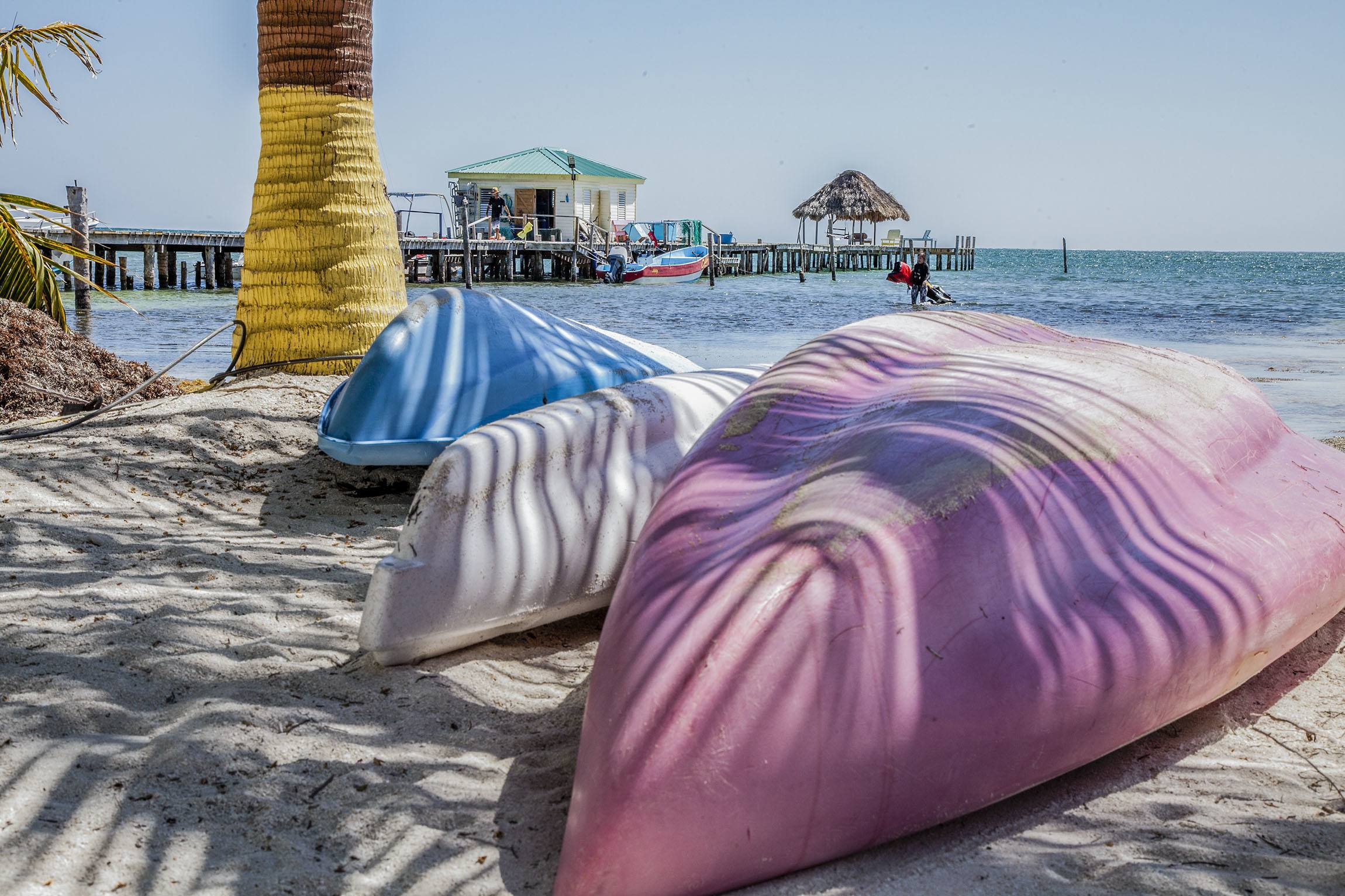
As you wander its sandy roads, the island’s two defining features become clear. First, the “Go Slow” philosophy that reshapes the way you think about time. And second, the unique cultural heartbeat that blends Rastafarian roots with a strong sense of community.
Together, they create an atmosphere unlike anywhere else.
What “Go Slow” Really Means in a World That Won’t Stop
On the surface, “Go Slow” sounds like just another charming island catchphrase, the kind of thing you see on a souvenir T-shirt. But within hours of arriving on Caye Caulker, I realised it’s far more than that — it’s a lifestyle, a mindset, and something I desperately needed.
In everyday life, like so many others, I was drowning in constant notifications, deadlines, and the pressure to stay “productive.” Holidays, for some, can also feel like another checkbox to tick — seeing every landmark, trying every recommended activity, snapping every photo for Instagram. But on Caye Caulker, none of that seemed to matter.
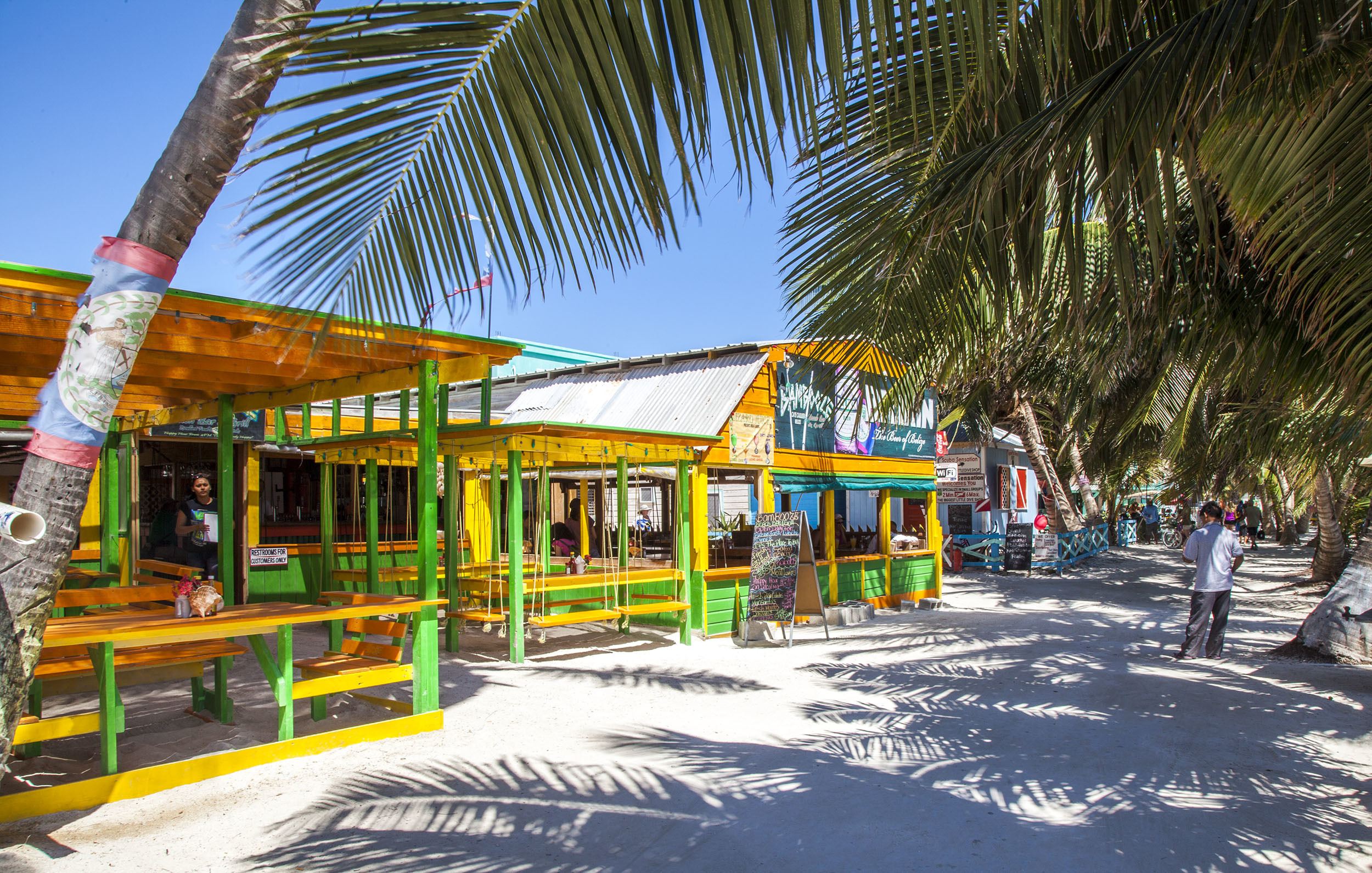
You can’t rush on an island where time is measured by the sun and the tides. Roads are sand, transportation is by bike or golf cart, and the biggest decision of the day might be which hammock to claim. The first day, I instinctively checked my emails with frequency — only to realise there was no Wi-Fi in half the places I wandered.
By day two, I had forgotten where I’d even stashed my devices.
For me, “Go Slow” wasn’t just a cute slogan — it was an invitation to step back, breathe, and remember what it feels like to simply exist. On an island with no traffic lights and no rush hour, I relearned how to listen to my own rhythm instead of the world's.
► Why It Matters in Today’s World
The “Go Slow” philosophy has never been more relevant. The world is spinning faster than ever, and many of us are struggling to keep up — burnout, anxiety, the inability to disconnect.
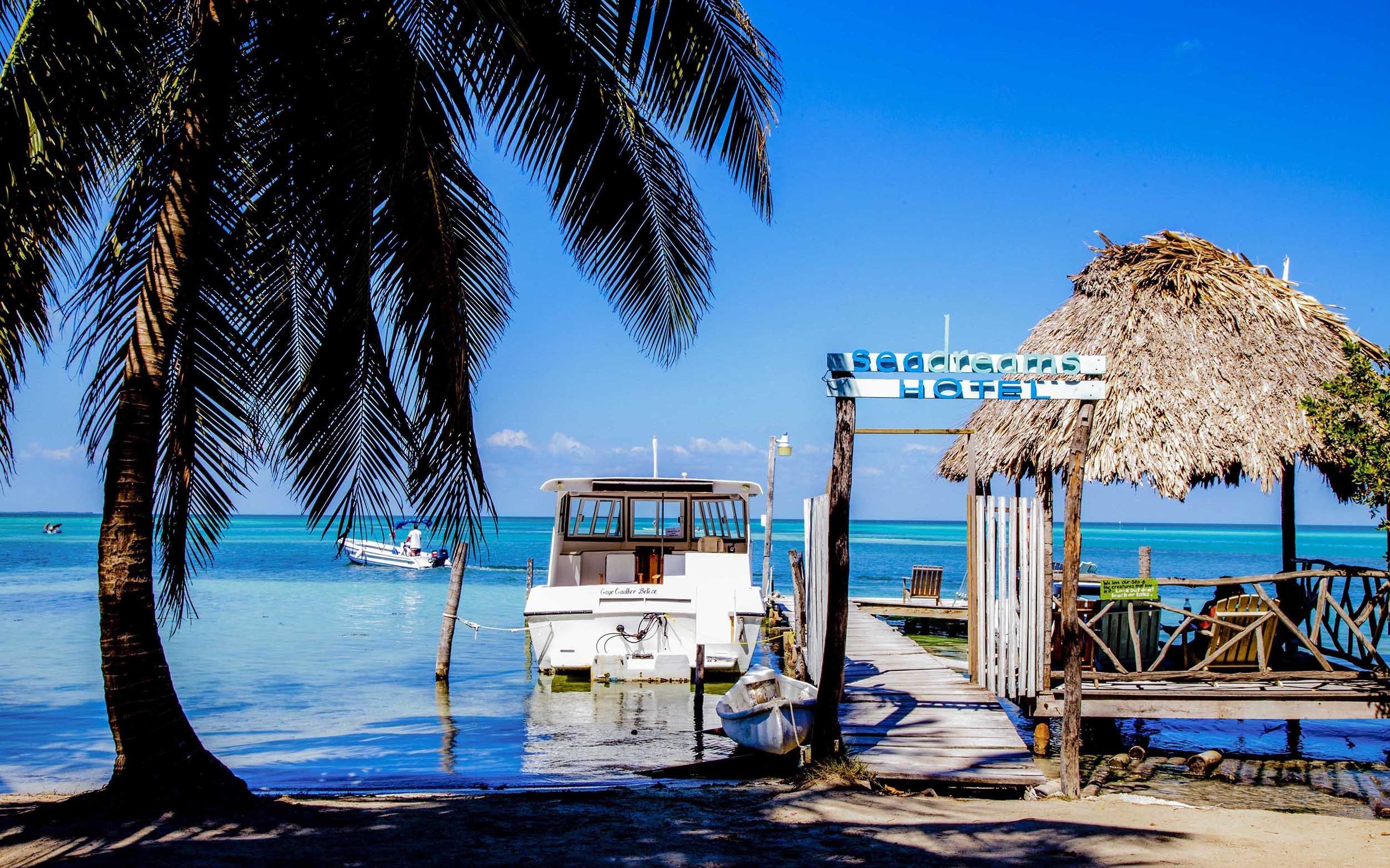
Caye Caulker reminded me that slowing down isn’t laziness; it’s survival. It’s essential. And I carried that lesson forward with me, where I now give myself permission to slow down when I need it.
The Rastafarian Influence: A Culture That Colours Caye Caulker
If you’ve spent any time wandering the sandy streets of Caye Caulker, you’ve probably noticed it: the laid-back reggae vibes, the bright colours of red, green, and gold, and the locals greeting you with a friendly “No worries, man.” Rastafarian culture is woven into the fabric of this island, but not in the way you might expect.
► How Rastafarianism Arrived on Caye Caulker
Rastafarian culture first came to Belize via Jamaica, with its mix of music, spirituality, and resistance to colonialism. Over time, it found a home on Caye Caulker, blending with the island’s Creole roots and the rhythms of daily life.
Today, Rastafarian ideals — self-reliance, connection to nature, and living simply — fit seamlessly with the “Go Slow” philosophy that defines the island.
► Meeting the Locals Who Live It
One of my favourite moments was meeting a local guy who embodies this way of life. With dreadlocks swaying in the breeze and a smile that could disarm anyone, he explained how Rastafarianism isn’t just about music or style — it’s a way of living in harmony with the world.
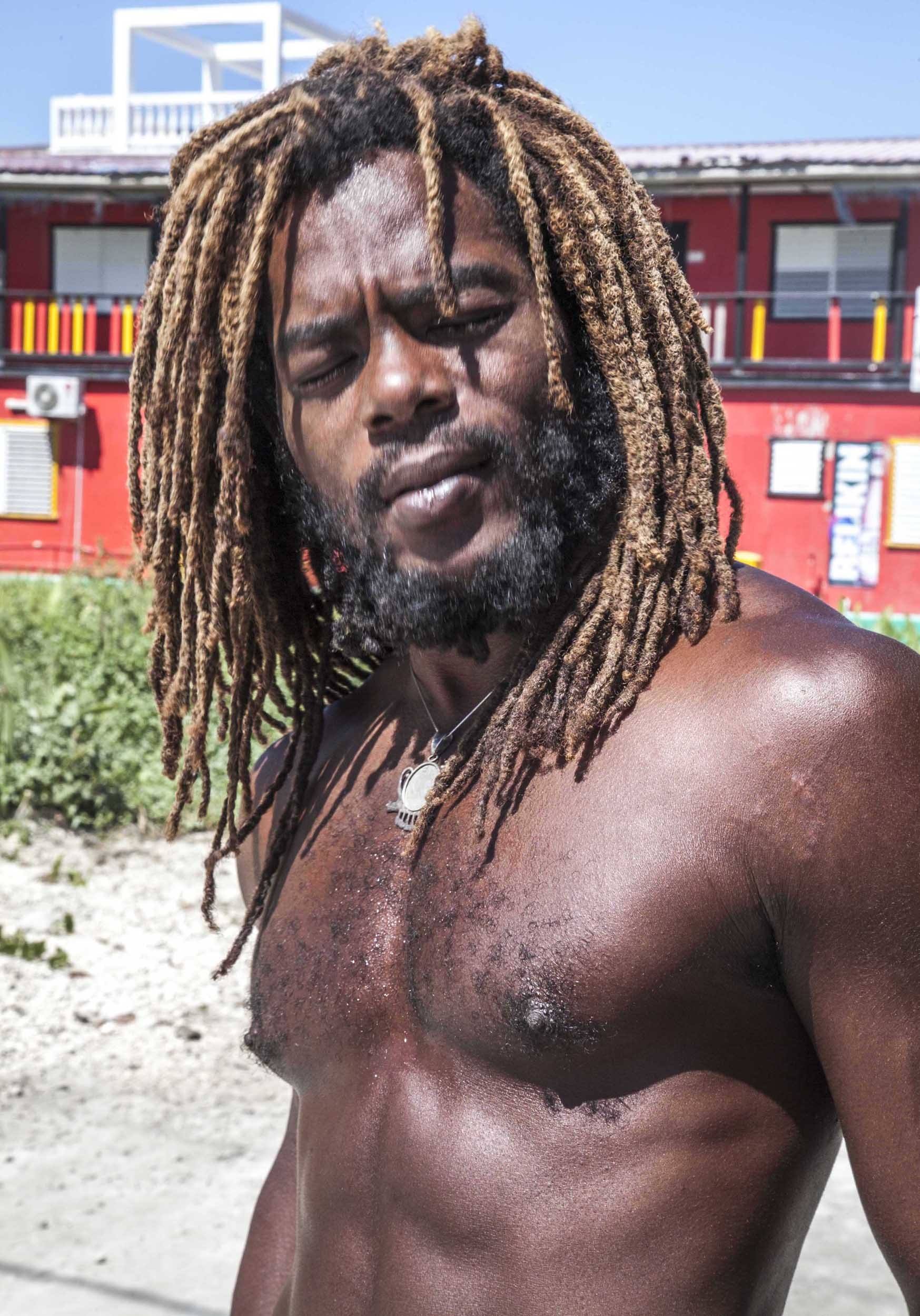
“We’re not in a rush, man,” he said, as we stood in the sun, thinking about ordering food from a stall. “Rush for what? Life’s happening right now, right here.”
► The Music and Vibe of Caye Caulker
Reggae music drifts through the air, whether you’re walking to the Split or grabbing a bite of fresh seafood. It’s not forced or touristy — it feels like the natural soundtrack to life here.
And the Rastafarian presence isn’t about commercialising Bob Marley quotes; it’s a reminder of a simpler, more intentional way of living.
► A Fun and Engaging Twist
You can even see Rastafarian influence in the quirky humour around the island. Signs reading “No shirt, no shoes, no problem” or “No money, big problem” aren’t just jokes — they’re reflections of a mindset that values simplicity but knows the importance of keeping things real. It’s this blend of wisdom and wit that gives Caye Caulker its soul.
Things to Do and Experience on Caye Caulker
Caye Caulker isn’t about cramming your days with activities — it’s about finding joy in the simple things. The island encourages you to let curiosity lead the way, whether that’s diving beneath the waves, biking along sandy streets, or watching the sun sink into the horizon.
Here, the experiences aren’t rushed or prepackaged. They unfold naturally, shaped by the rhythm of the island and the people who call it home. Whether you’re snorkelling alongside nurse sharks or enjoying a quiet moment at The Split, every moment feels like it belongs to you.
Dive into Marine Adventures
“Don’t worry, be happy.” The words floated across the breeze from our Rastafarian yacht captain, his voice as smooth as the reggae music drifting from the speakers. With dreadlocks catching in the midmorning wind and an effortless smile, he steered us toward Hol Chan Marine Reserve, one of the highlights of Caye Caulker’s underwater world.
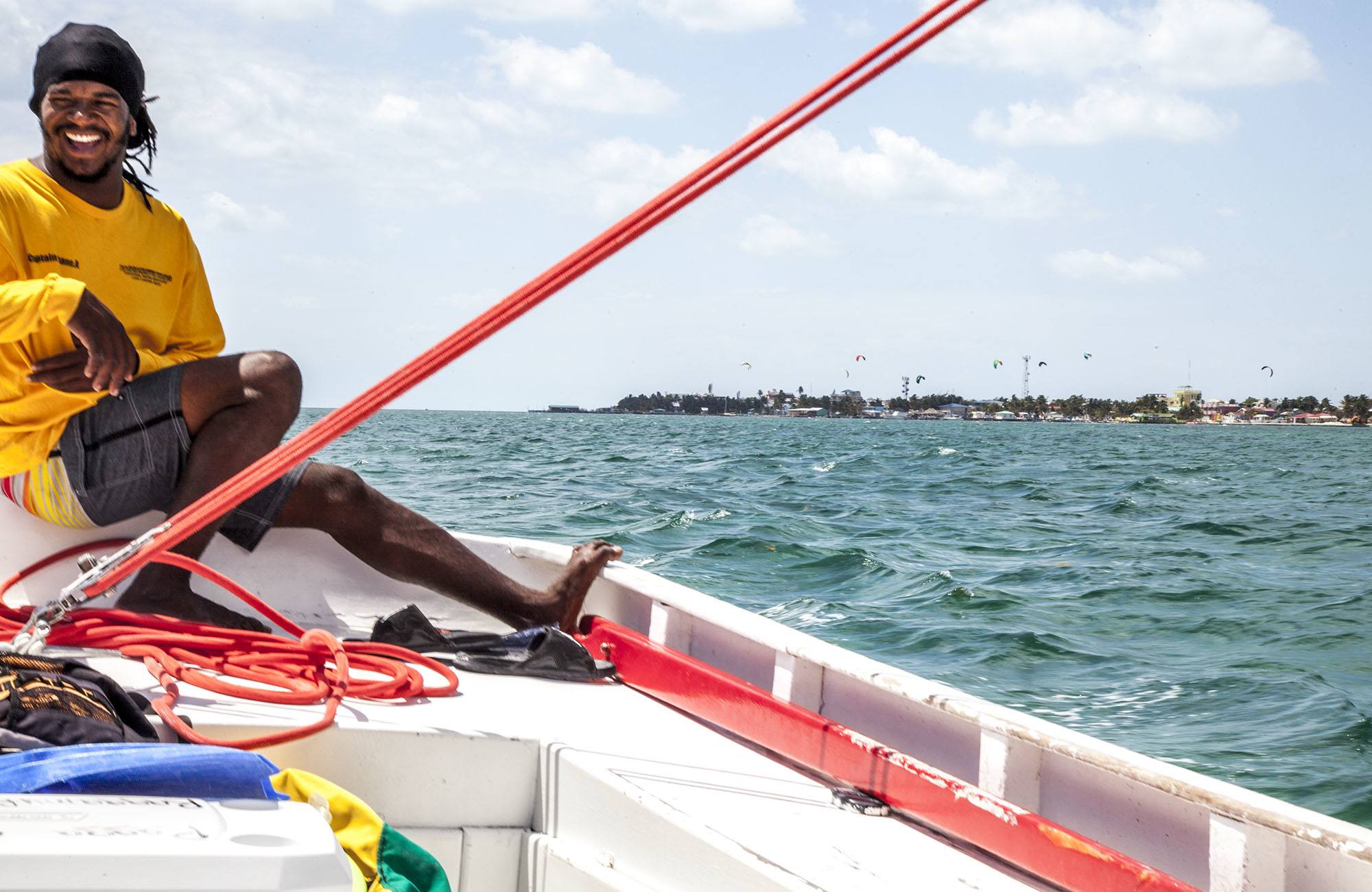
As we neared the first stop, the captain’s laid-back charm set the tone for the day. “No worries, man. It’s gonna be fine yah. Shiiiit.” His playful humour melted any lingering tension, and soon we were dropping off the side of the boat, snorkels on, into the shimmering turquoise shallows.
► Hol Chan: A Trance Beneath the Waves
The first thing I saw was a giant sea turtle, gliding gracefully alongside a baby nurse shark. They moved in harmony, as though rehearsed, their slow, fluid motion drawing me into their rhythm. The turtle seemed entirely unbothered by our presence, a living embodiment of calm. For a moment, time itself felt like it stopped.
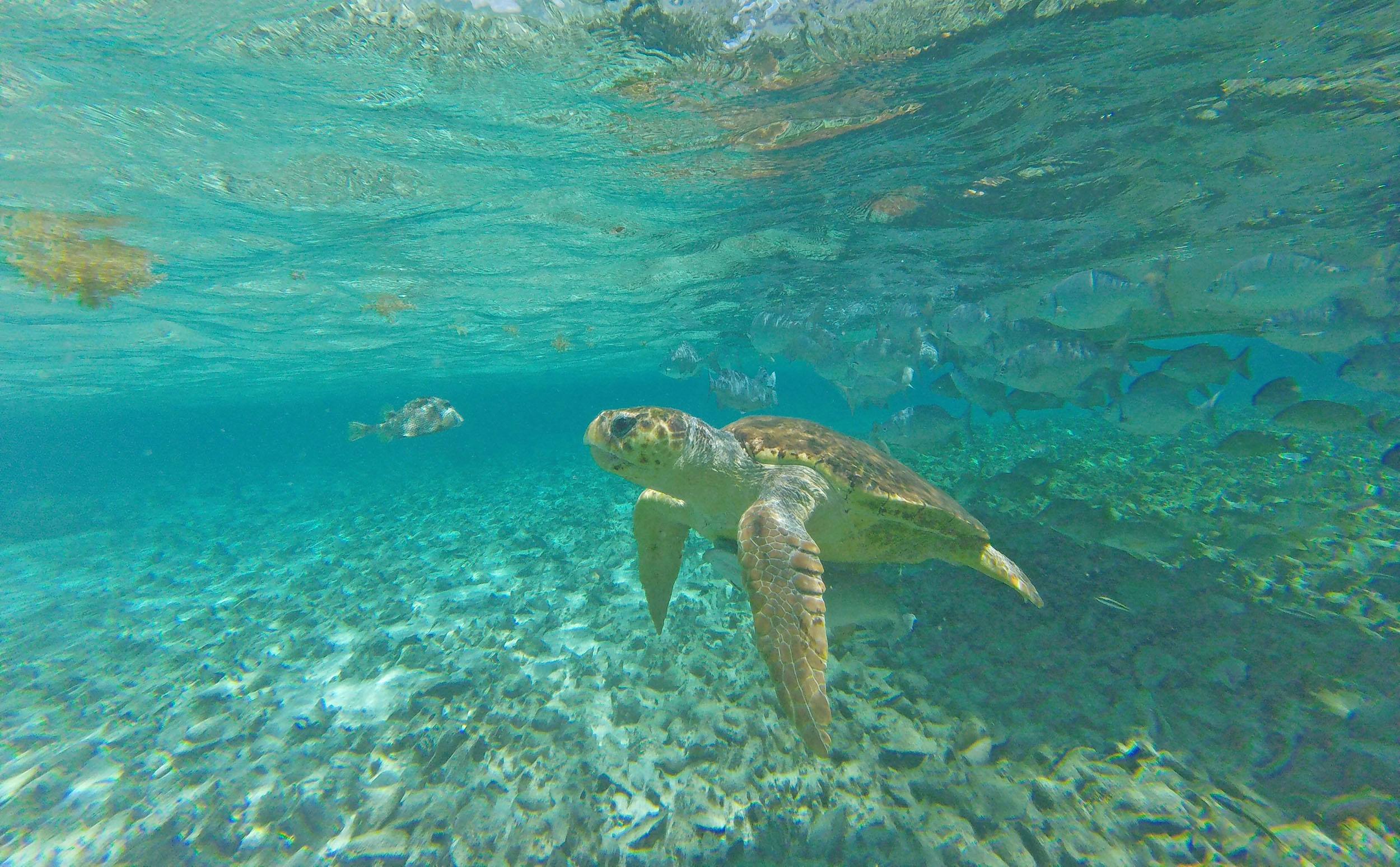
Every movement underwater felt otherworldly — the glint of sunlight on scales, the quiet murmur of distant fish. Hol Chan wasn’t just a snorkel stop; it was a glimpse into an underwater kingdom where life continued, undisturbed, in ways we could only admire.
► Shark and Ray Alley: Close Encounters
Our next destination was Shark and Ray Alley, a name that admittedly raised both excitement and apprehension. “They can’t bite; their mouths are too small,” said our captain, with a wink and a cheeky grin. “But if you see one this big,” — he stretched his arms wide — “then swim like hell because it’s gunna get you.”
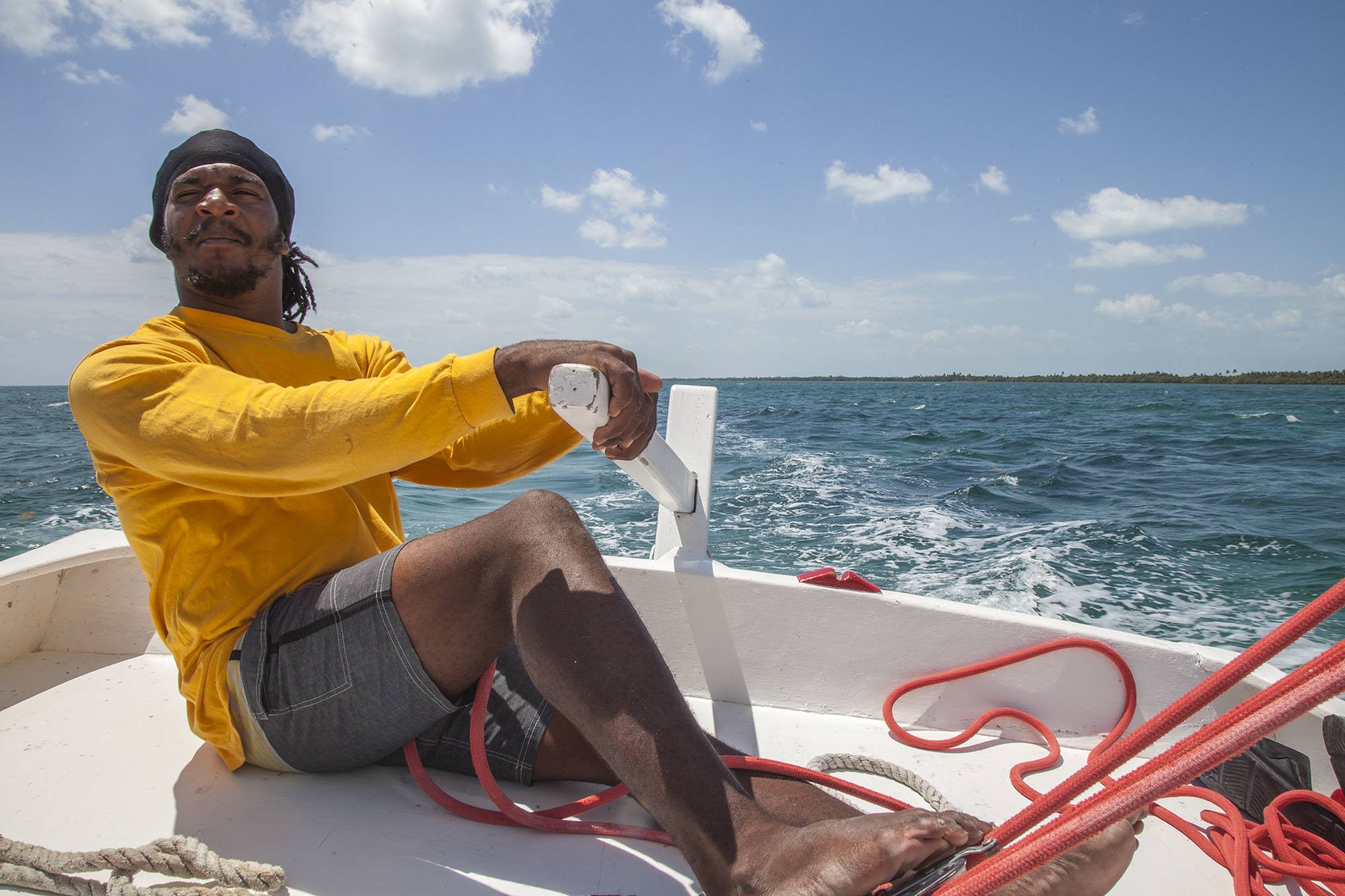
With a laugh that dissolved any nerves, we plunged in once again.
Below us were at least fifteen nurse sharks, gliding along the seafloor, their movements languid and purposeful. Swimming mere meters away, I extended my arm — not in fear, but in awe. Their presence felt oddly calming, as though they were indifferent to our curiosity but willing to share their space.
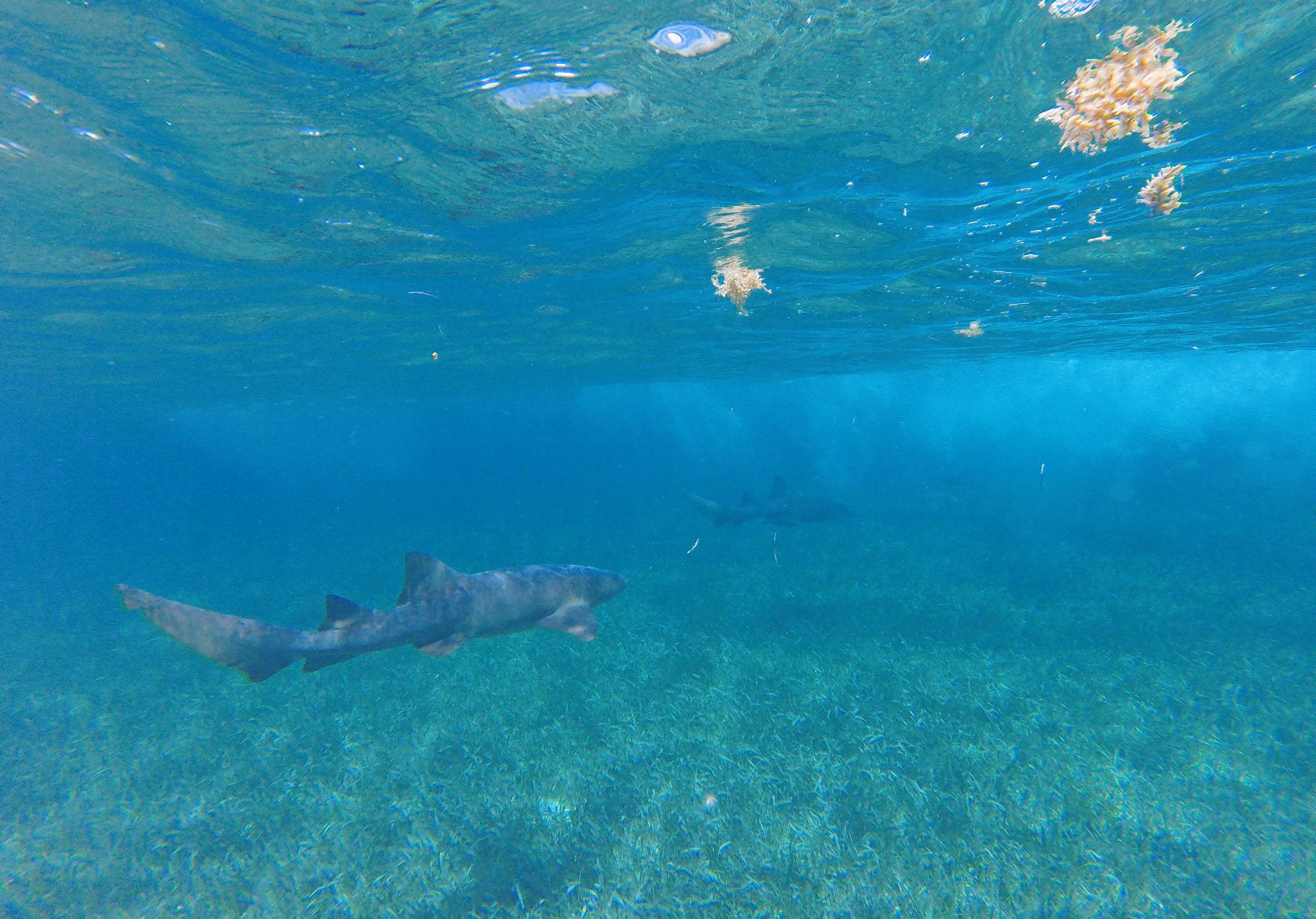
Moments later, stingrays joined the scene, their wings slicing through the water like liquid shadows.
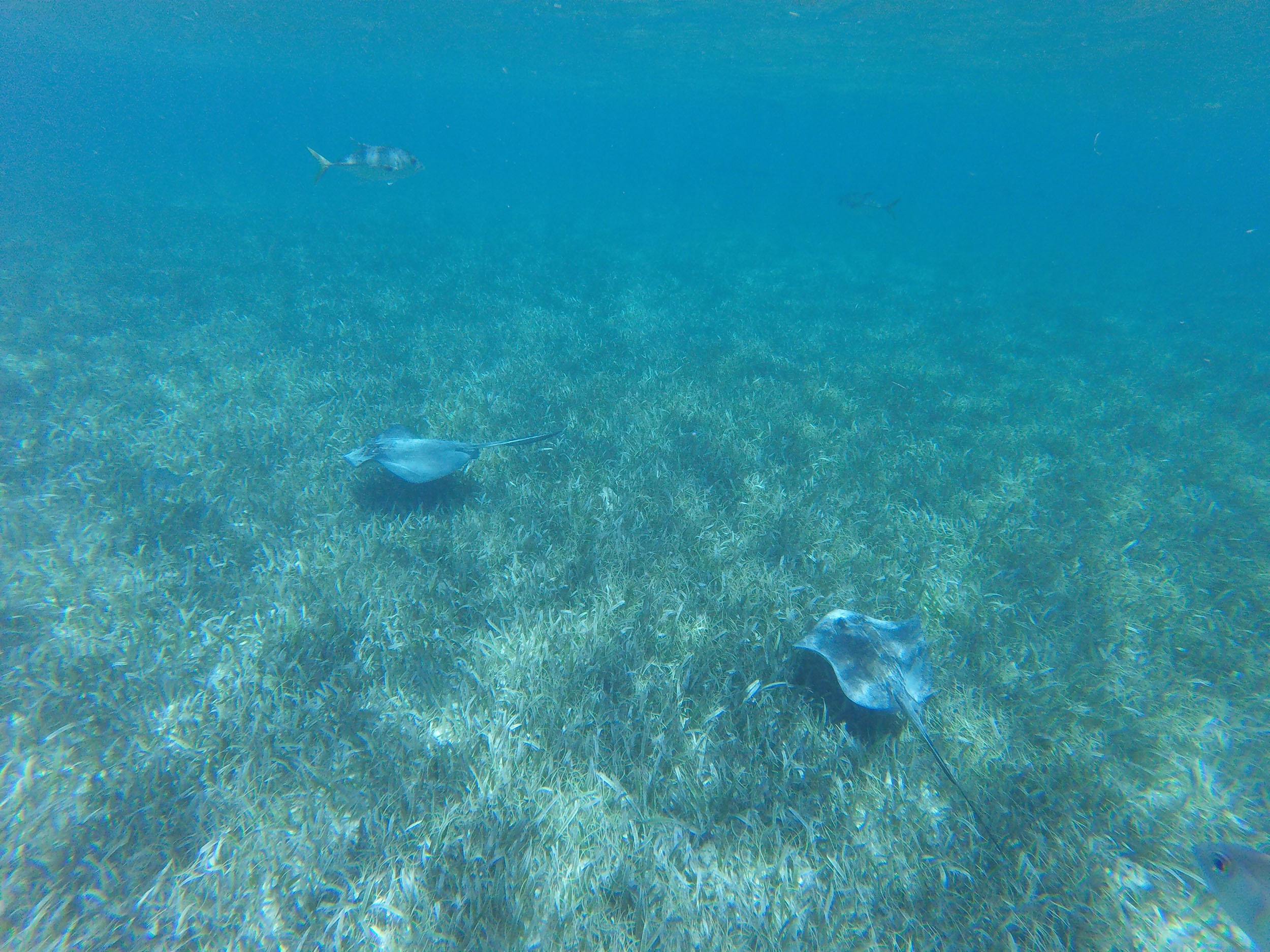
One passed so close beneath a fellow snorkeler that it stirred a flicker of fear — memories of Steve Irwin came rushing back. But like the sharks, the stingrays moved with an elegant disinterest, unbothered by our intrusion.
► The Connection to Caye Caulker’s Rhythm
Everywhere I looked, the underwater world seemed to mirror the pace of life above. The slow, deliberate movements of turtles, sharks, and rays felt like an extension of Caye Caulker’s “Go Slow” philosophy. It wasn’t just a slogan — it was an ecosystem.
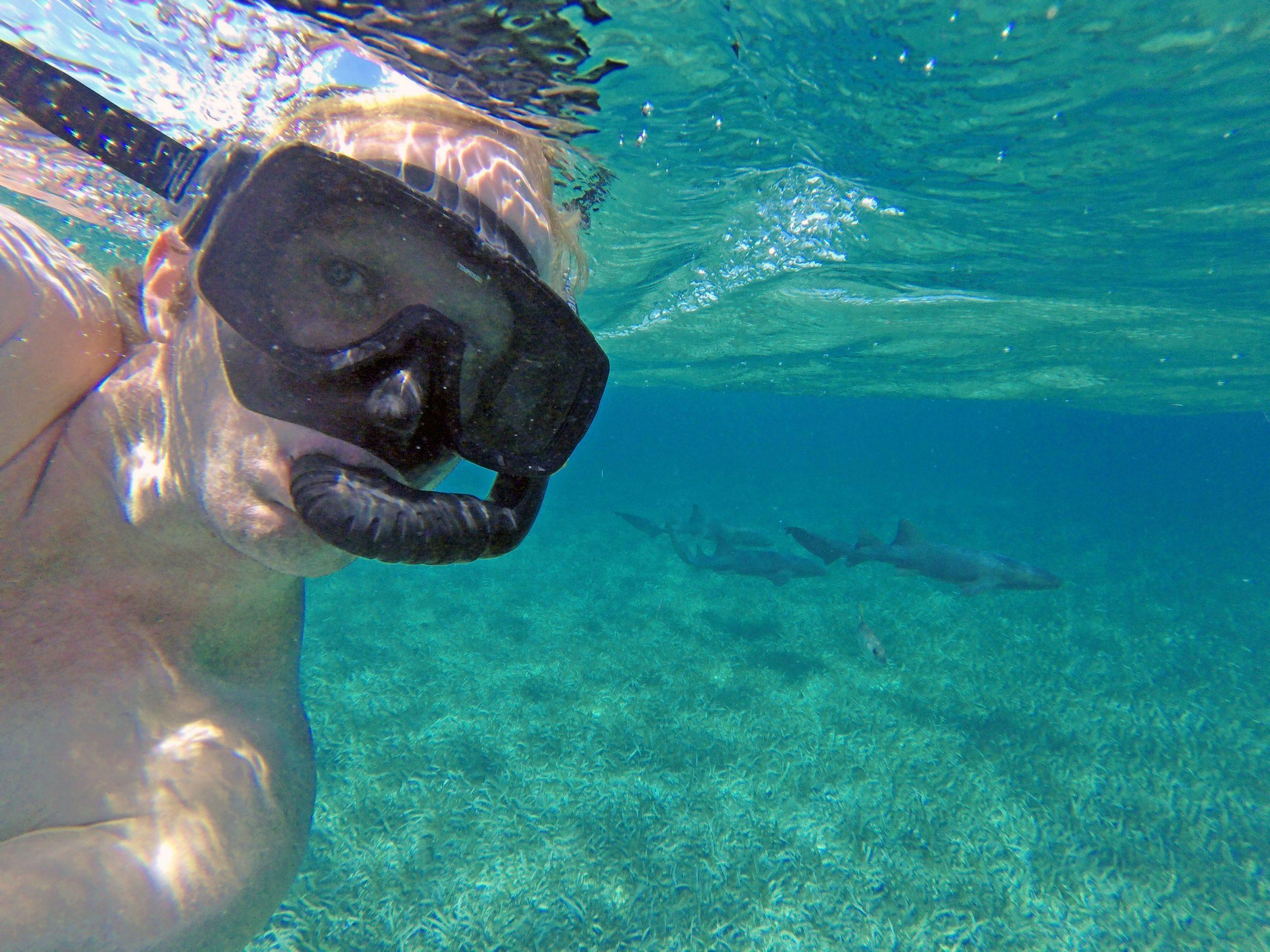
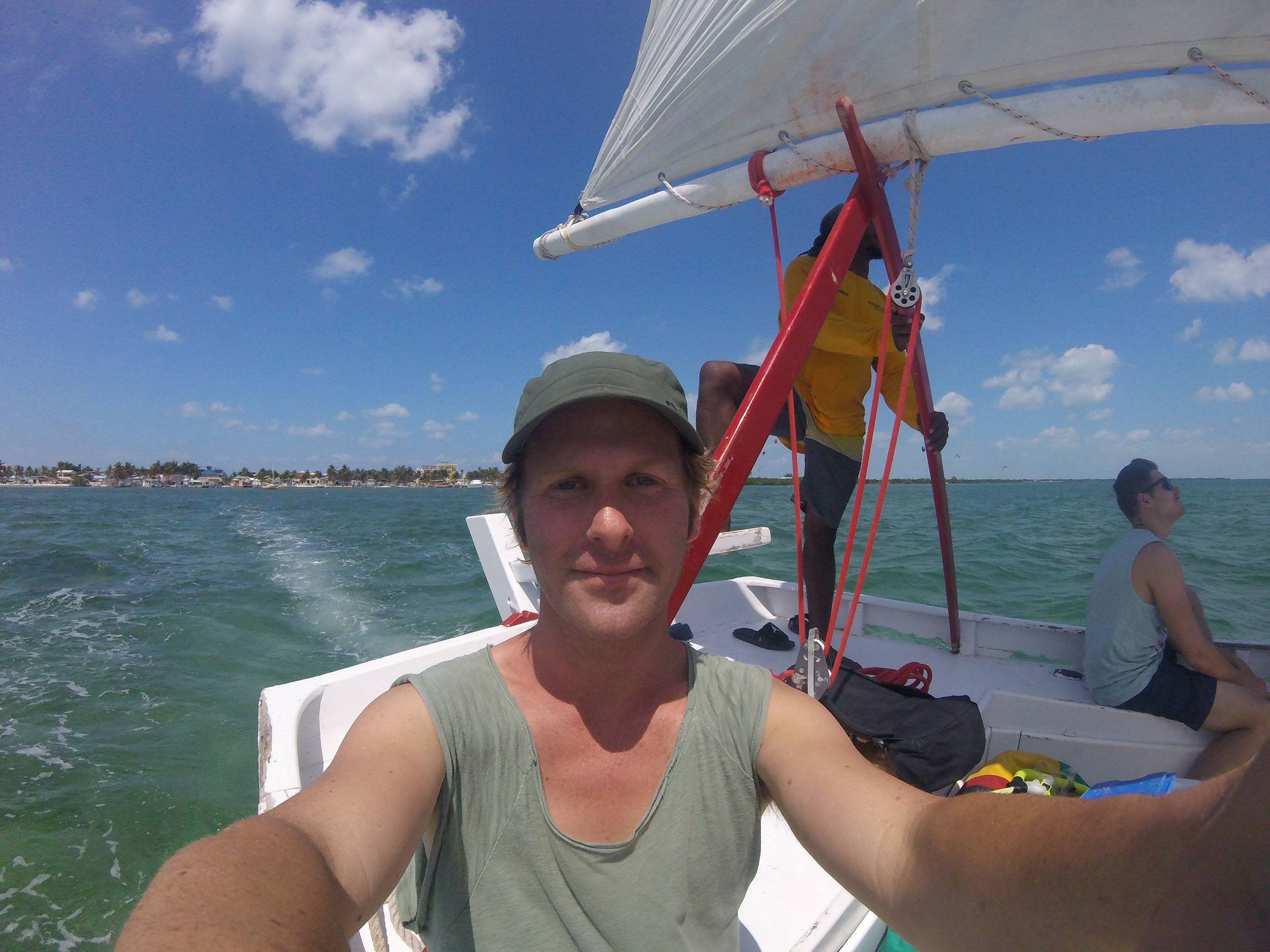
As we sailed back under the afternoon sun, I couldn’t shake the feeling that I’d seen something profound. This wasn’t just a tour or an activity — it was a reminder of how connected we are to the natural world, a world that asks us to slow down and truly see it.
Relax on The Split
The Split is where the island gathers, slows down even further, and lets the day unfold. Whether you’re swimming in the calm turquoise waters, sipping a cold Belikin beer at the Lazy Lizard, or watching the sun dip below the horizon, this is where life on Caye Caulker feels most effortless.
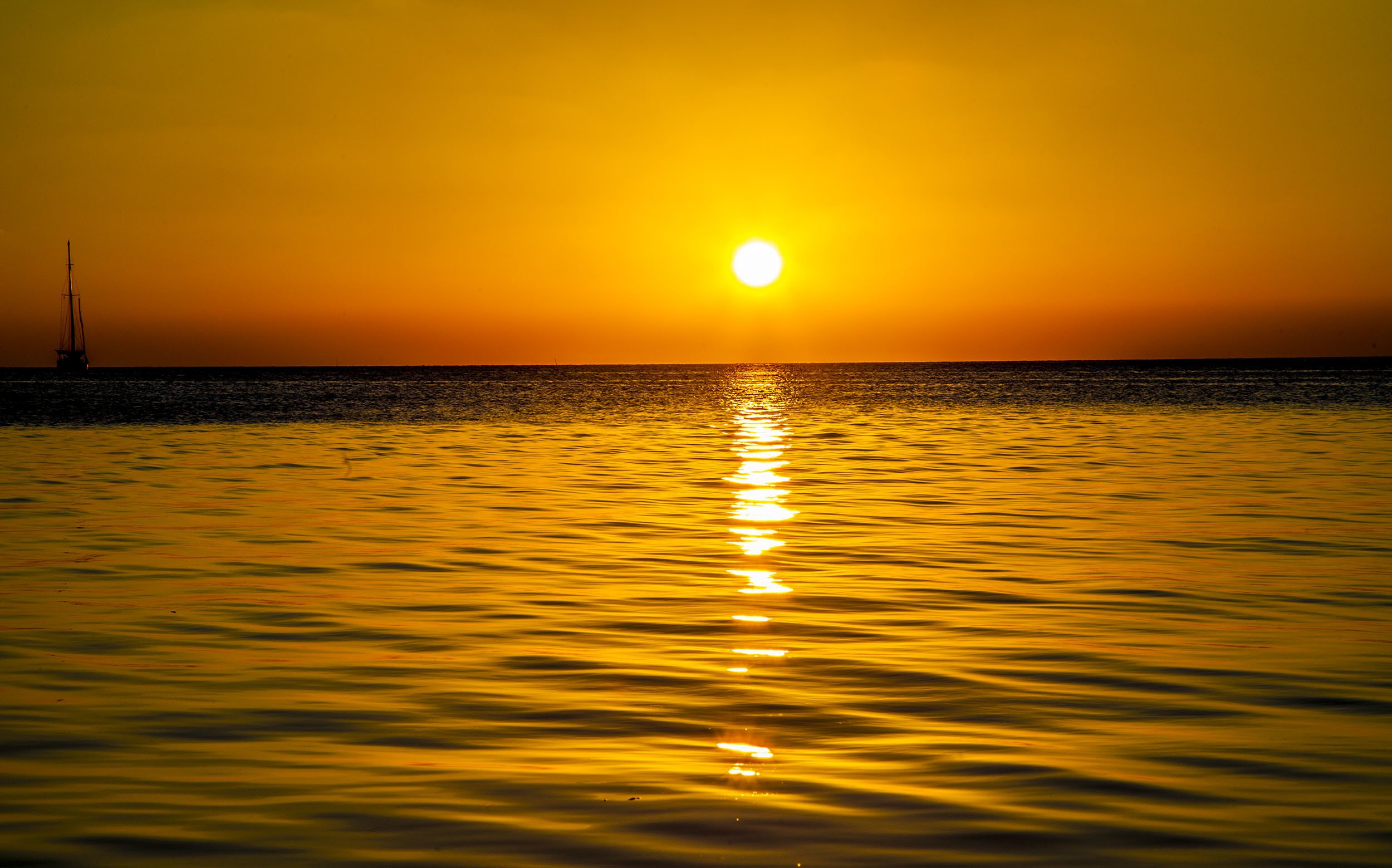
There’s no agenda here, no rush. Locals and travellers alike drift between the water and the shoreline, chatting, laughing, and soaking in the kind of moments that feel endless. The Split is a reminder to let go and simply be.
Explore the Island by Bike or Golf Cart
Caye Caulker’s sandy roads and compact size make it perfect for exploring on two wheels — or four, if you prefer a golf cart. I chose a bike, and it felt like the ideal way to experience the island. The rhythm of pedalling through sun-dappled streets mirrored the island’s “Go Slow” motto, and I loved how easily I could stop to explore whenever something caught my eye.
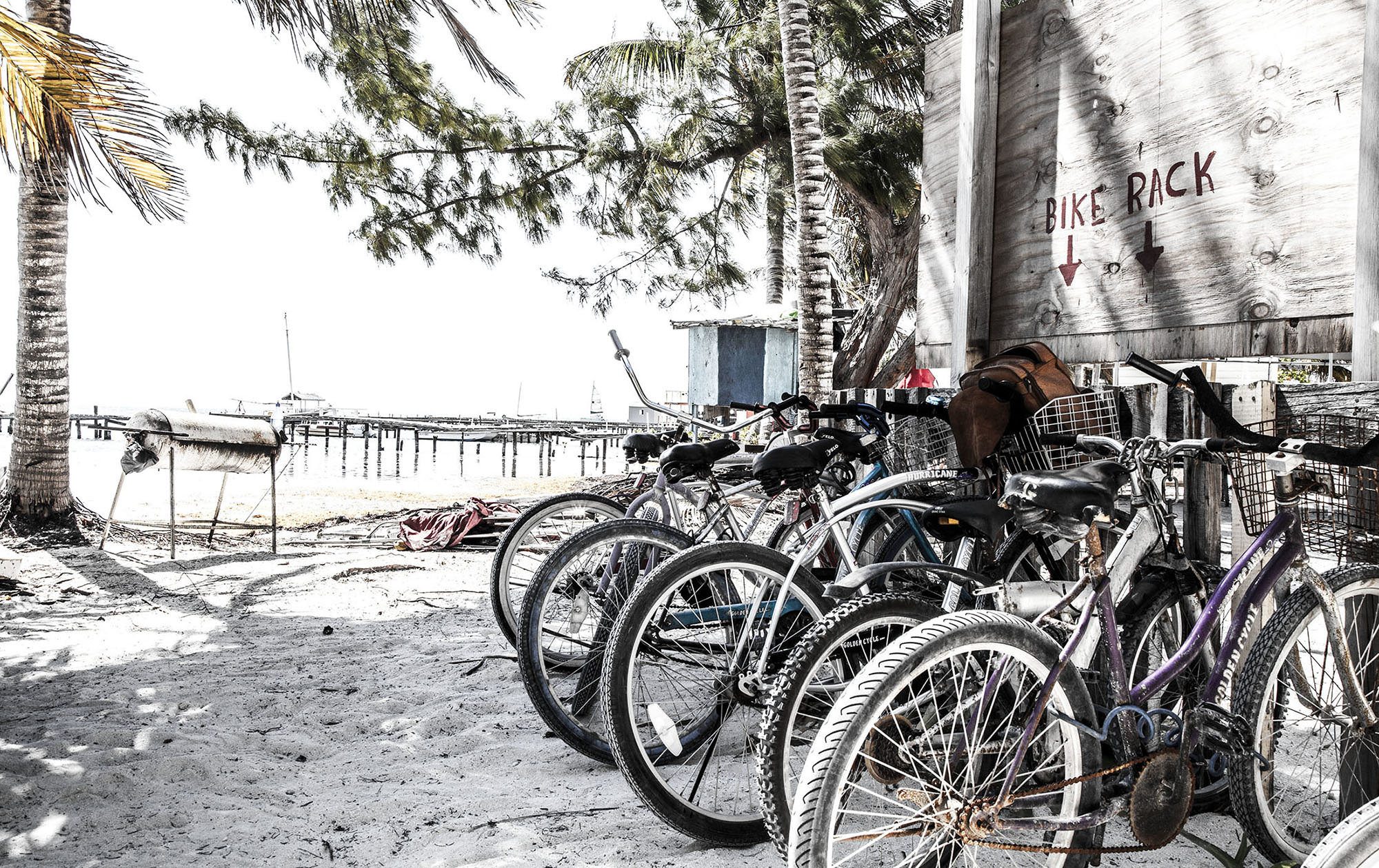
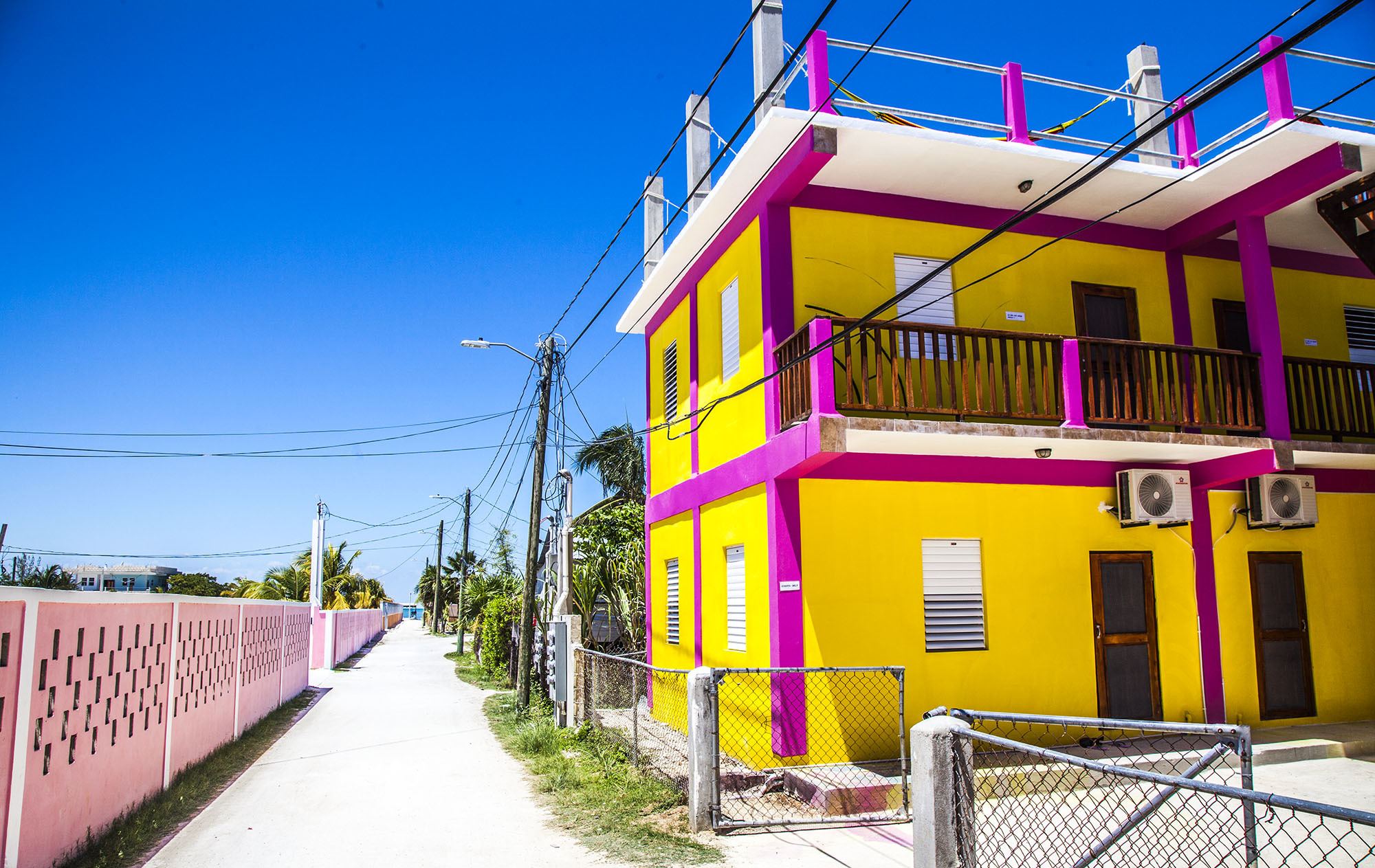
Whether it’s cycling past vibrant beachside homes, stopping at a local food stall, or heading toward quieter stretches of coastline, the journey itself becomes part of the adventure.

With no cars to dodge and a breeze to keep you cool, biking on Caye Caulker isn’t just transportation — it’s pure joy.
Take Day Trips to Nearby Attractions
While Caye Caulker has plenty to keep you grounded, nearby spots like Ambergris Caye or the mainland's jungle adventures are just a short ride away. But honestly, with adventures like snorkelling at Hol Chan or Shark Ray Alley already at your doorstep, you might find yourself perfectly content staying close to home.
Discover Caye Caulker’s Unique Culture
Caye Caulker’s culture is as relaxed and welcoming as its “Go Slow” motto suggests, but there’s more to it than meets the eye.
The island’s character is a blend of its Creole roots, Rastafarian influences, and a rhythm of life shaped by its sandy streets and turquoise waters. Here, even the smallest moments feel imbued with personality.
A Community of Smiles and Simplicity
Stepping off the jetty, I was immediately struck by the unhurried charm of the island. Golf carts weaved lazily along the sand-covered road, dodging the occasional cyclist or dog stretched out in the sun. The atmosphere was infectious — smiles came easily, conversations flowed naturally, and it felt as though everyone had all the time in the world to enjoy life.
The island’s sense of community became even clearer during my stay.
On my first walk toward the Split, I passed shop walls plastered with the motto “No shirt, no shoes … no problem. No money, big problem.” The humour was as casual as the dress code, where shoes are optional and shirts are barely considered. This blend of wit and warmth felt like a mirror of Caye Caulker’s personality: easygoing, yet refreshingly honest.
The Rhythm of Rastafarian and Creole Roots
While “Go Slow” defines the pace, the island’s Rastafarian influence adds a distinctive beat. Rastafarian ideals of living simply and staying connected to nature feel perfectly at home here. These values seamlessly intertwine with Creole traditions, creating a cultural vibe that’s both unique and harmonious.
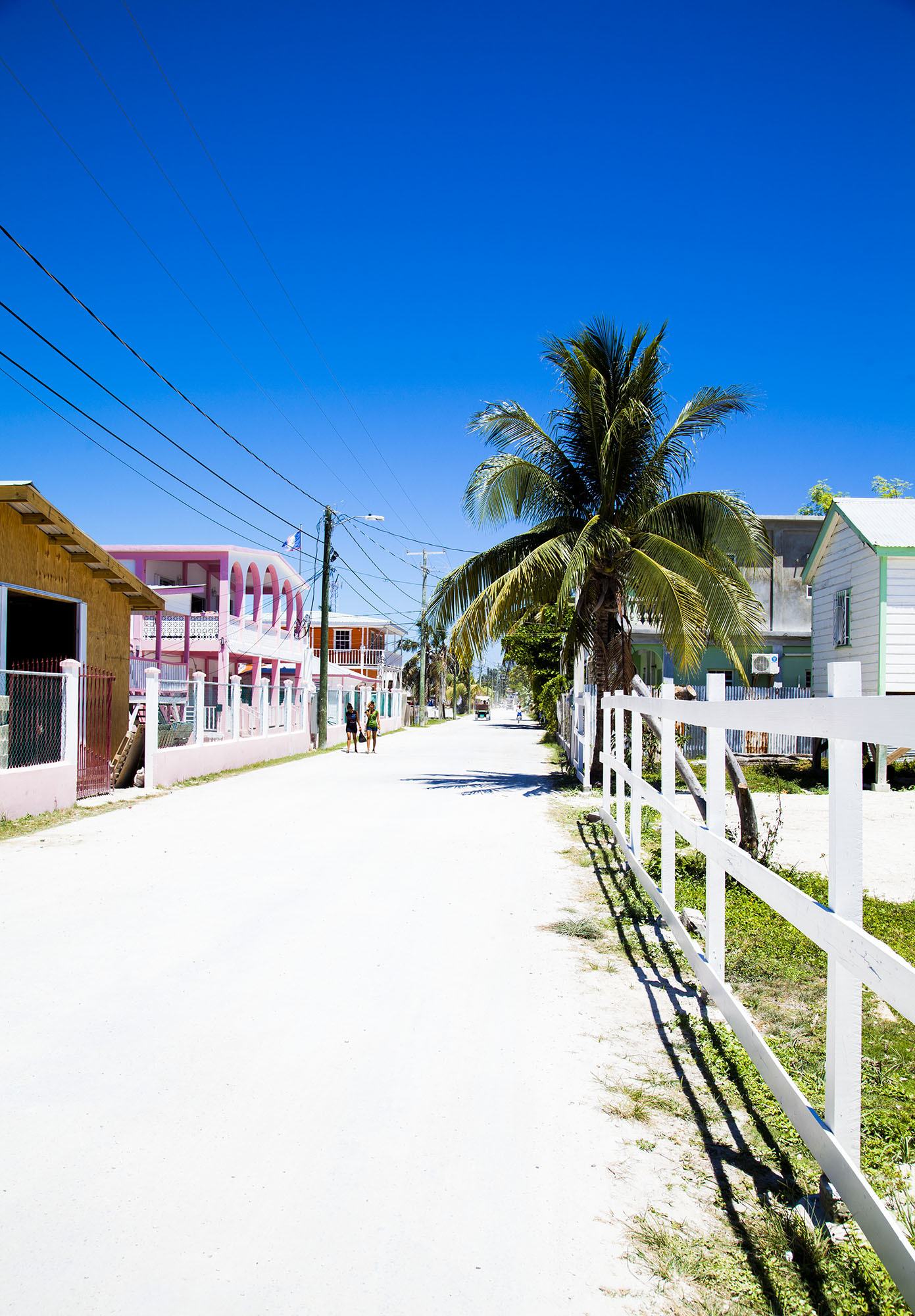
As I biked along the sandy roads, reggae music drifted out from small shops and beachside stalls, mixing with the laughter of locals and visitors alike. The influence is subtle, but unmistakable — it’s not about commercialising a style but about embedding it into everyday life. From the colours of the houses to the casual conversations on street corners, the cultural roots of the island run deep.
Local Cuisine You Can’t Miss
Food on Caye Caulker is more than just nourishment — it’s an introduction to the island’s Creole heritage. Every meal feels fresh, local, and unpretentious, from grilled lobster served at beachside shacks to rich stews brimming with Caribbean spices.
Start your day with fry jacks — a fried dough delicacy often paired with eggs or beans.
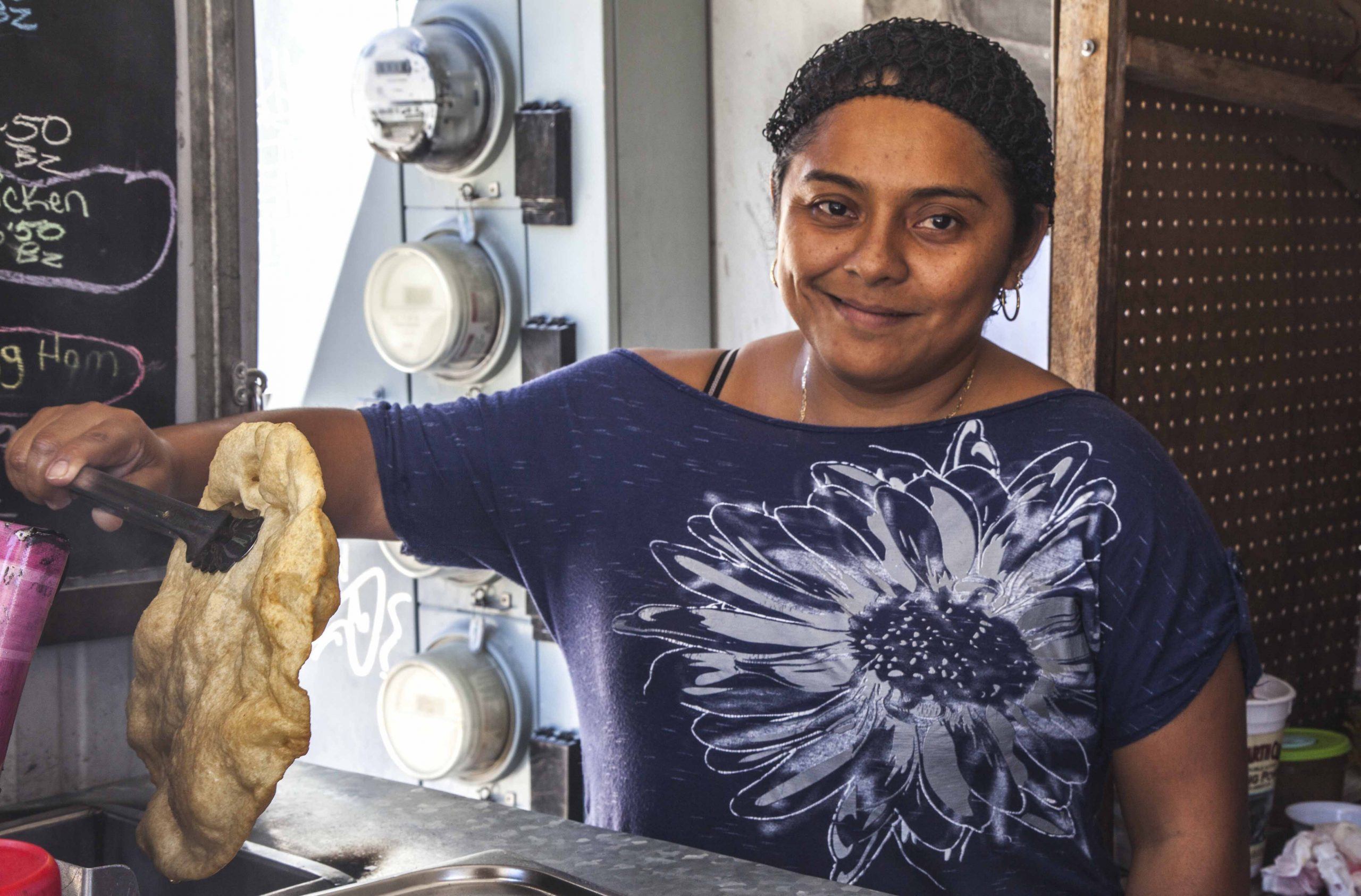
For lunch or dinner, don’t miss stewed chicken with rice and beans, a Creole staple. Street vendors serve ceviche packed with fresh-caught seafood, while small restaurants prepare lobster straight off the boat during the island’s famous Lobster Fest.
And for dessert? Look out for coconut tarts or tropical fruit sorbets.
The island’s eateries are as laid-back as the rest of Caye Caulker, with plastic tables set in the sand and the sound of waves as your soundtrack. It’s not fancy, but it’s perfect.
Festivals and Events
Caye Caulker might be small, but it knows how to celebrate. The island’s most famous event, Lobster Fest, kicks off lobster season each year with a burst of flavour and festivity. Local chefs compete to create the most mouthwatering dishes, and the streets come alive with live music, dancing, and an unmistakable sense of community pride.
Other celebrations often revolve around food, music, and togetherness, with locals and visitors gathering to enjoy the island’s cultural heritage. Even outside of formal events, the island’s easy-going nature turns ordinary evenings into small celebrations — like live reggae nights at beachside bars or casual bonfires under the stars.
Where Culture Meets the Island's Rhythm
Culture on Caye Caulker isn’t something you visit; it’s something you feel. It’s in the way locals laugh with ease, the way shop owners greet you like an old friend, and the way every hammock seems perfectly positioned to catch the breeze. Even the humour is distinctly tied to the pace of life here.
One shop sign read, “We’ve got two speeds — slow and stop.”
This unique blend of culture and simplicity invites you to not just observe, but to take part. Whether you’re wandering through town, striking up a conversation with a Rastafarian guide, or savouring fresh fish caught that morning, every moment feels like a small, meaningful connection to the island’s essence.
Practical Information for Visiting Caye Caulker
Here's some practical information to help you plan your visit.
How to Get to Caye Caulker: Travel Guide
Reaching Caye Caulker is as much a part of the experience as being there. Whether you’re coming from Belize City or crossing the border from Mexico, the journey offers its own charm — scenic boat rides, glimpses of the turquoise Caribbean, and the first whispers of the island’s slower pace.
While water taxis and ferries remain the most popular choice, flights provide an aerial view of the islands that’s hard to forget. However you arrive, the destination makes it worth every mile.
Arriving from Belize City
Caye Caulker is easily accessible from Belize City, and the journey itself is part of the adventure. Most visitors opt for the water taxi, a scenic 45-minute ride across the sparkling turquoise waters of the Caribbean. The Belize Express Water Taxi and other operators run regular schedules throughout the day, and tickets cost approximately $15 USD one way.
If you’re short on time or want an aerial view of the islands, you can catch a quick flight from Belize City to Caye Caulker via Tropic Air. The flight takes less than 15 minutes and costs around $85–$100 USD one way. It’s a splurge, but the bird’s-eye view of the Belize Barrier Reef is unforgettable.
Travelling from Mexico
For travellers coming from Mexico, reaching Caye Caulker via Chetumal is both straightforward and enjoyable. My own journey began in Chetumal, where I emptied the bulk of my cash at the ferry terminal and boarded the Belize Express Water Taxi. Perched close to the water’s surface, the small boat zipped across the Gulf, its wake sparkling under the Caribbean sun.
Border formalities were a breeze — Mexico’s departure process was handled at the Chetumal terminal, while Belize’s entry formalities took place during a brief stop at San Pedro. The entire crossing was seamless, comfortable, and enjoyable, though I couldn’t help but notice the lack of a local presence on board.
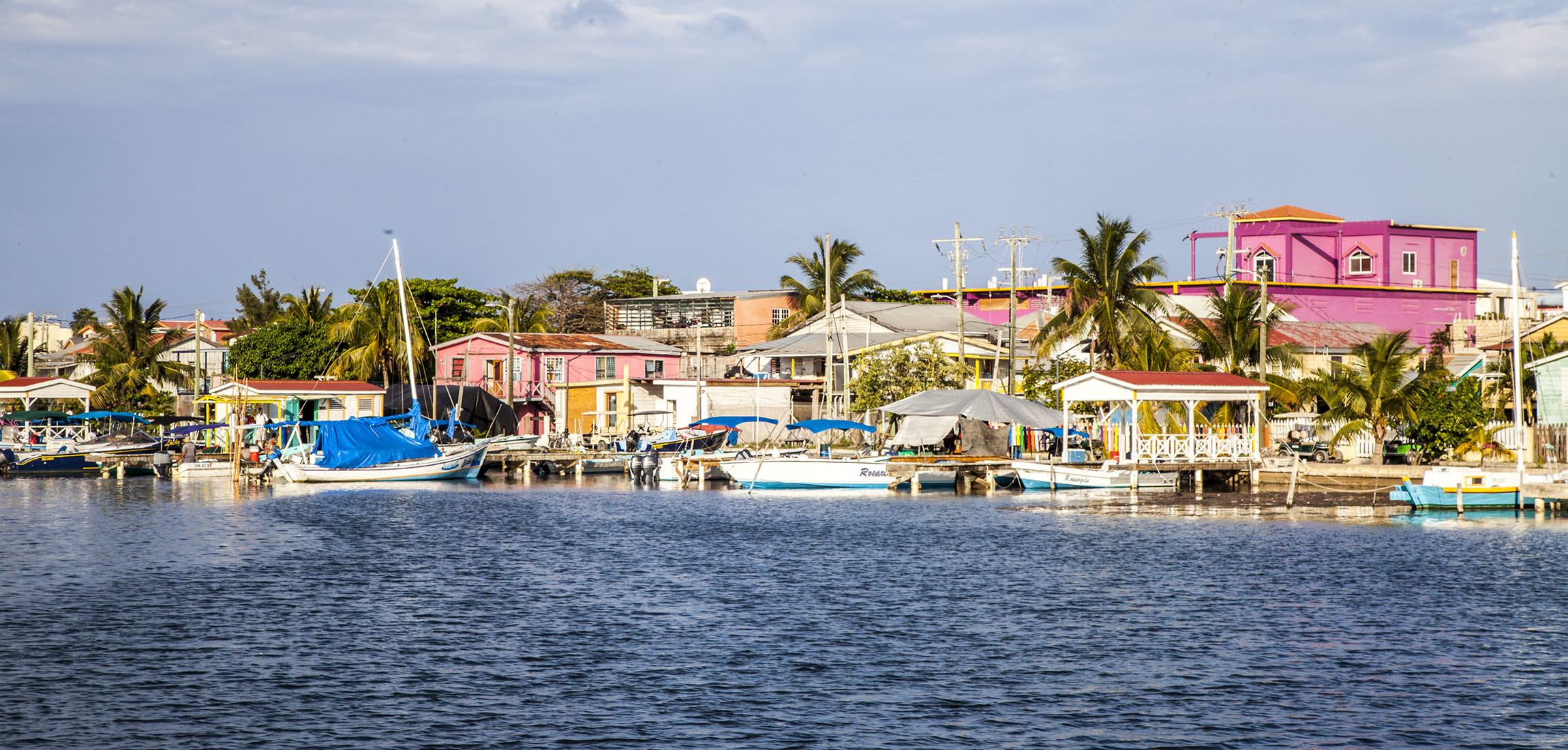
However, there’s one unavoidable hurdle: the Mexican departure tax. This variable fee ranges from $30–$50 USD and is rarely included in airfare for those arriving by plane. Even the most determined arguments at the Chetumal ferry immigration office are unlikely to spare you from paying it.
The only way to dodge this fee, I’m told, is by entering Belize via bus — but that’s for another trip.
Other Transportation Options
For those already in Belize, alternative ways to reach Caye Caulker include ferries from other coastal towns or a scenic flight. Whether you’re boarding a twin-engine plane from the mainland or “slumming it” on a slower ferry, the journey is just as memorable as the destination.
Where to Stay on Caye Caulker
Caye Caulker may be small, but it offers plenty of choices when it comes to accommodation. From budget-friendly hostels to beachfront hotels, this Caye Caulker travel guide covers some of the best places to stay on the island.
What they all have in common is a relaxed, no-frills charm that fits perfectly with the island’s ethos. Wherever you decide to stay, expect ocean breezes, friendly hosts, and a laid-back vibe that makes it hard to leave.
Budget: Go Slow Guesthouse
For budget travellers, Go Slow Guesthouse is a great choice, offering simple yet comfortable spaces just 60 metres from Caye Caulker Beach. I stayed here and liked the relaxed vibe, free bike rentals, and the communal garden with a barbecue area, perfect for meeting other travellers.
WiFi is available throughout the property.
Mid-Range: Caye Caulker Beach Hotel
If you’re after a mid-range stay, Caye Caulker Beach Hotel is a solid choice just a stone’s throw from the beach. The basic rooms are air-conditioned, have private bathrooms, and there’s a shared lounge and terrace to chill out. With free WiFi, a snack bar, and bikes for hire, it’s a great spot to soak up the island vibes.
High End: Colinda Cabanas
For a mid-to-high range stay, Colinda Cabanas is a beachfront gem with 14 suites and cabanas that offer stunning views of the world’s second-largest barrier reef. Each room comes with a private patio or balcony, complete with a hammock for relaxing island-style.
You'll have access to bikes, kayaks, and snorkel gear, along with a 150-foot swimming pier and plenty of loungers. The on-site café is perfect for starting your day with a latte or fresh smoothie.
Tips for Visiting Caye Caulker
Caye Caulker’s charm lies in its simplicity, but a little preparation goes a long way toward making your trip as enjoyable as possible.
Whether you’re wondering about the best time to visit or what to pack, these tips will help you blend seamlessly into island life. The slower pace and welcoming locals create the perfect environment for a memorable trip — just be ready to adapt to the rhythm of “Go Slow.”
Best Time to Visit Caye Caulker
Caye Caulker’s tropical climate makes it a year-round destination, but the best time to visit is during the dry season, from late November to mid-May. This period offers warm days and minimal rain, perfect for snorkelling, biking, and soaking up the sun.
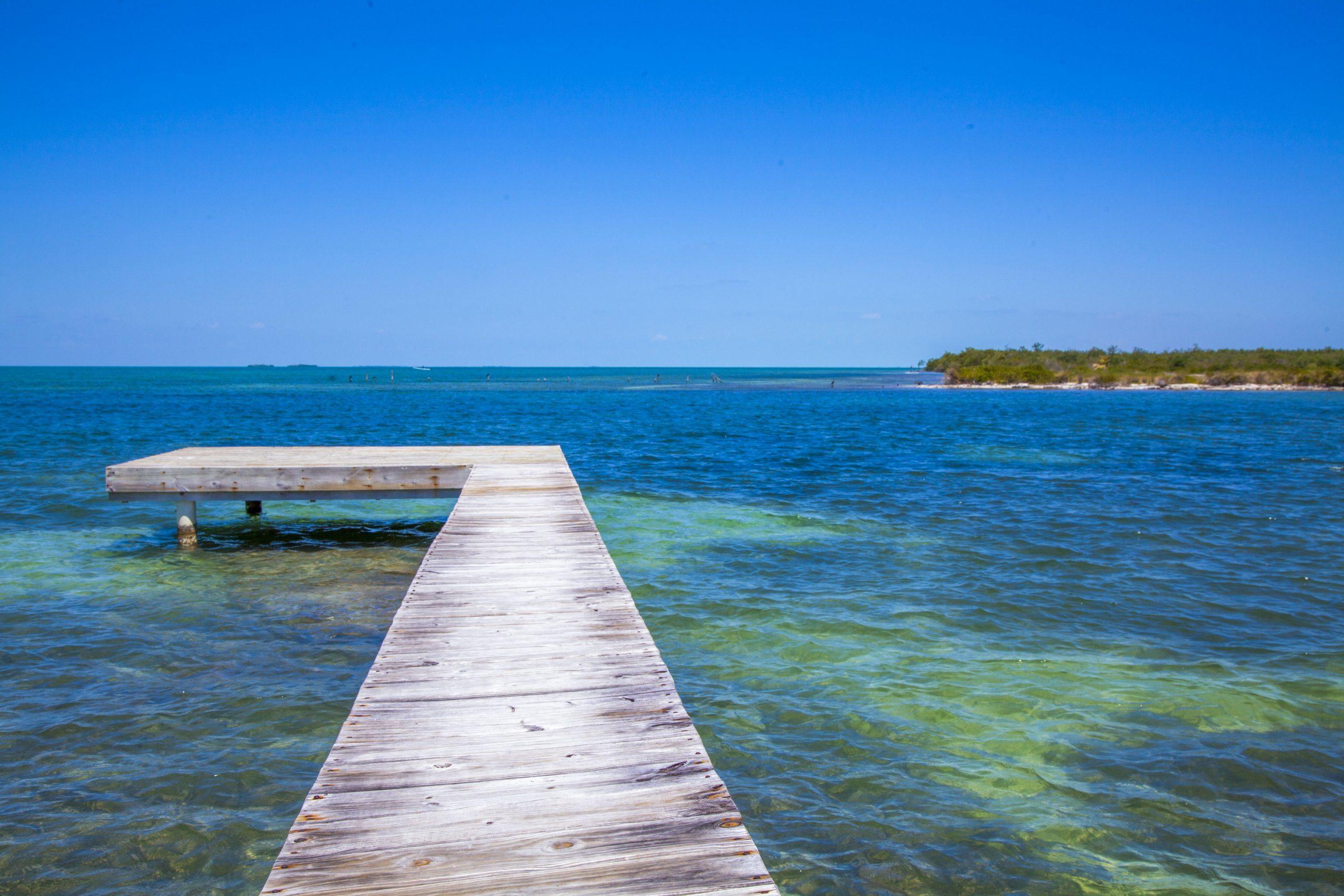
The wet season (June to October) brings occasional downpours but fewer crowds, which might appeal to travellers seeking a quieter experience.
Visa Requirements
Belize offers visa-free entry to many travellers, including but not limited to citizens of European Union countries and those with valid Schengen visas.
However, nationals of certain countries, such as Afghanistan, Nigeria, and China, among others, must obtain a visa in advance.
For a full list and the latest requirements, visit the official Belize Immigration website.
Packing Essentials for Island Life
Less is more on Caye Caulker.
Pack light, breathable clothing, swimsuits, and sandals — shoes are optional on this sandy island. I also packed sun protection, bug repellent, and a reusable water bottle to stay hydrated.
Leave the formalwear at home; the island’s laid-back vibe doesn’t call for anything fancy.
Staying Safe on Caye Caulker
Caye Caulker is generally safe, but it’s always wise to stay mindful. Stick to well-lit areas at night, secure valuables, and use common sense when exploring.
For water activities, always go with reputable tour operators and follow safety instructions, especially when snorkelling or diving.
Caye Caulker for Solo Travellers
As a solo traveller, I found Caye Caulker to be one of the easiest places to navigate alone. The island’s small size and its “Go Slow” pace made it feel safe and welcoming, almost like a small-town community where everyone knows each other. Within hours of arriving, I’d already shared stories with fellow travellers at my hostel and exchanged laughs with locals at a roadside food stall.
Snorkelling trips were a natural way to connect with others. Between the excitement of spotting nurse sharks and the shared awe of Caye Caulker’s underwater beauty, strangers on the boat quickly became friends.

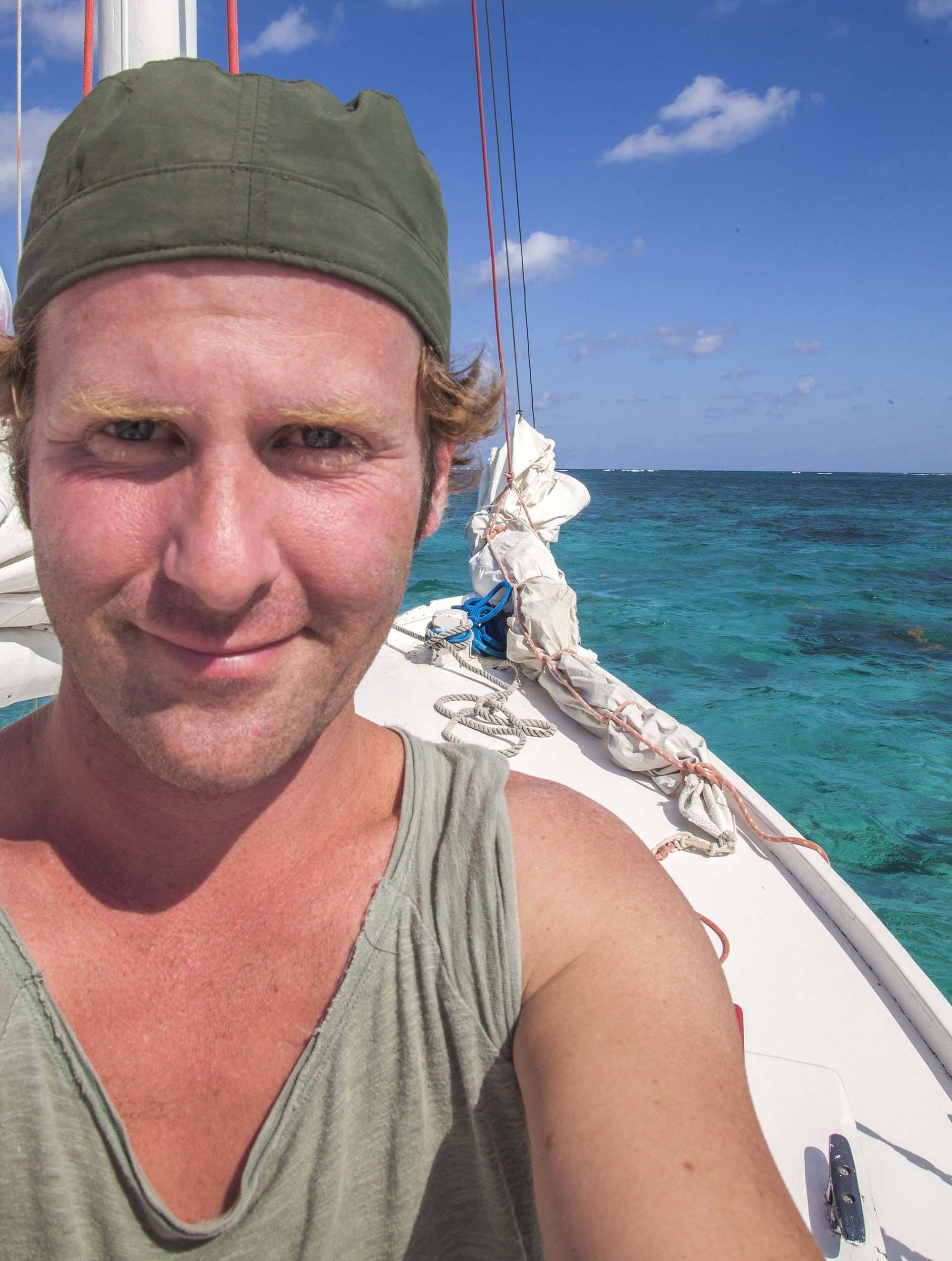
Even quiet moments — like biking solo along sandy roads or sitting at The Split with a book — never felt lonely. The friendly vibe of the island meant someone was always ready for a chat, whether it was another traveller or a local eager to share their love for the island.
Caye Caulker doesn’t just cater to solo travellers — it embraces them. It’s the kind of place where being alone doesn’t feel isolating; it feels freeing.
Getting to Know Locals
Locals on Caye Caulker are known for their warmth and humour, and engaging with them can enrich your experience. Strike up a conversation at a food stall or take a guided tour with someone who knows the island inside out.
A simple “hello” goes a long way here.
Staying Healthy
The island’s casual vibe might tempt you to forget basic health precautions, but it’s important to stay mindful.
Drink bottled or filtered water to avoid stomach issues and use sun protection liberally to protect yourself from the strong Caribbean sun. If you plan to indulge in seafood (and you should), stick to reputable eateries to ensure freshness.
Save this article for future reference!
Conclusion: Why You’ll Never Forget Caye Caulker
Caye Caulker isn’t the kind of place that fades into the background of your travel memories — it stays with you. It’s in the easy laughter of the locals, the rhythm of reggae floating on the breeze, and the moments where time seems to slow down just for you.
For me, it wasn’t just the turquoise waters or the swaying palm trees that made it unforgettable — it was how the island gently reminded me to breathe, to connect, and to embrace the present. Whether it’s your first solo trip or your hundredth, Caye Caulker offers a kind of freedom that’s hard to find anywhere else.
This little island doesn’t demand your attention; it earns it, quietly and completely. And long after you’ve left, you’ll find yourself thinking back to the hammocks, the sunsets, and the simple joy of going slow.
I hope this Caye Caulker travel guide has inspired you to visit one of Belize’s most unforgettable islands. Whether you’re exploring solo or with friends, Caye Caulker promises a rewarding experience.
